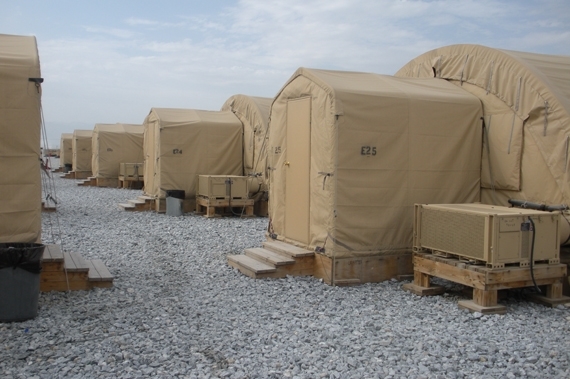The Evolution and History of Military Tents in the U.S.
- August 19, 2015
- Category: Air Force, Alaska Defense Applications, Fabric Buildings

Militaries around the world have used tents for shelter and protection since ancient times. The smallest unit of a Roman legion was a contubernium, or tent group, which included eight soldiers who shared a tent.
Today, some of the largest military bases in the world continue to use military tents in the form of fabric structures, proving their value in varying weather conditions.
From Forts to the Front Lines
The military was the driving force behind innovations in tents and shelters until the 20th century, when recreational camping became popular. Warfare in history was quite different from today, beyond the weapons. During wartime, military bases didn’t really exist outside of forts here in the United States, therefore troops needed temporary housing that they could easily transport.
Temporary shelters, such as military tents were the most common shelter system for officers and troops during both the Revolutionary and Civil Wars.
Revolutionary War typically used a material called ‘duck’, which was made from cotton or hemp. These army tents offered American troops the shelter and camouflage they needed for both safety and guerilla warfare.
Unfortunately, the material had two major disadvantages:
- There were constant shortages because it had to be imported
- It often rotted due to negligence in maintaining it
After the Spanish American War, efforts were made to develop waterproof fabric materials. Military tents began to be made from khaki material, and camouflage cloth was created.
Civil War Innovations: Pup and Marquee Tents
During the Civil War, Union soldiers slept in small tents they nicknamed ‘pup tents’, allegedly because they claimed the shelters were better suited to shelter a dog than a man. They were notoriously prone to the elements, and were rarely anything close to waterproof.
However, they were lightweight and compact for carrying the distances the soldiers had to travel between battles. Meanwhile, officers and generals planned their battle strategy from larger meeting tents called ‘marquee’ tents.
Advancements Through the 20th Century
Military tent design continued to develop through World War II, the Korean War and Vietnam War. Innovations in:
- Tent pole design
- Material type
- Waterproofing
- Size l
Led to more effective solutions for various weather conditions.
The Modern Era of Military Shelters
After Desert Storm, the US Air Force decided to request new shelter/tent technologies from industry due to the problems encountered with the use of MASH tents and General Purpose (GP) tents in the Middle East.
In 1998, Alaska Defense was awarded the first of many production contracts for the US Air Force. Since 1999, the rest of the US military, including US Special Operations Command, has used Alaska Shelters for operations in the Middle East and around the world.
Today’s Military Tents: Portable, Durable, and High-Tech
Today, military tents and fabric structures for military encampments are incredibly durable. They are even preferable over brick-and-mortar buildings in a variety of cases, due to:
- Their portability
- Their versatility
These high-grade military tents demonstrate how far military shelter technology has evolved, combining strength, energy efficiency, and rapid deployment capabilities.
Need Military-Grade Shelter?
Companies such as Alaska Defense continue to move the military tent industry forward with advances in composites and lightweight metals.
As a leading supplier of military tents, Alaska Defense combines with independently tested and certified engineering, those high-tech components allow us to manufacture 21st-century military shelters that:
- Can be set up in less than 10 minutes
- Can be equipped with high performance military HVAC systems
- Shatterproof, energy-efficient LED lighting systems.
For more information about Berry Amendment-compliant Alaska Defense Military Shelters or to order yours today, call +1-575-541-9116 or email inquiry@alaskastructures.com.